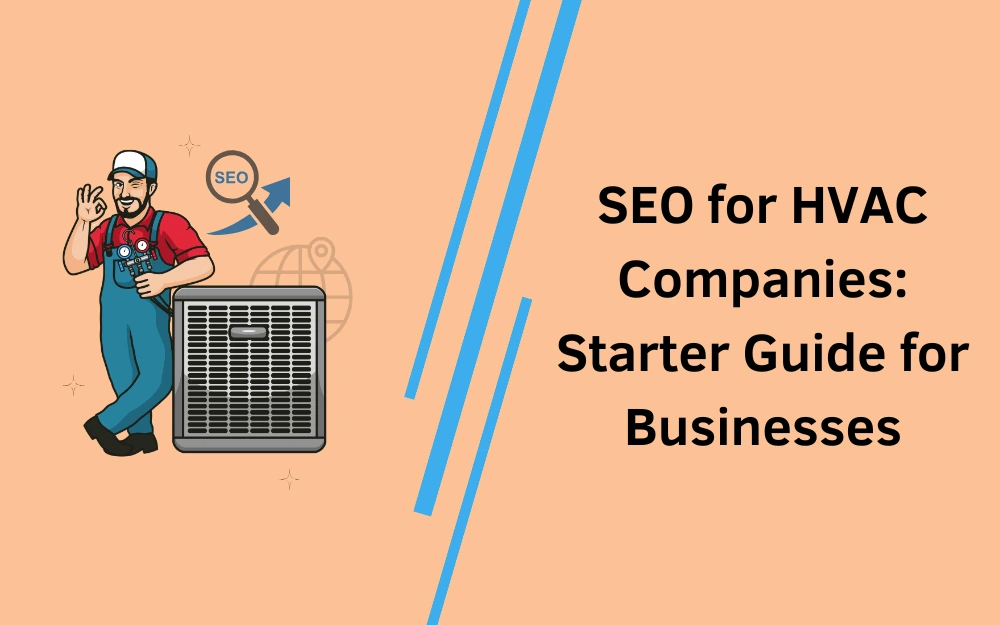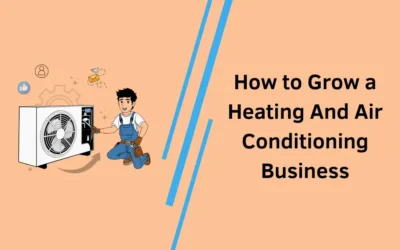Did you know that 78% of local mobile searches lead to an offline purchase? Ranking high in local searches like “AC repair near me” or “furnace installation in [city]” isn’t optional — it’s essential. By optimizing your website and Google Business Profile, you’ll drive targeted traffic, capture more leads, and stay ahead of local competitors. This guide outlines proven SEO strategies designed for HVAC businesses seeking to grow and dominate their local market.
Key Takeaways for HVAC SEO Success
- Claim and fully optimize your Google Business Profile to boost visibility in local searches and attract nearby, ready-to-buy customers.
- Target local and long-tail HVAC keywords to capture high-intent leads actively searching for your services.
- Publish geo-specific, value-driven content that answers customer questions, ranks in local search, and establishes your authority.
- Ensure your website is fast, mobile-friendly, and SEO-optimized to improve rankings, increase traffic, and deliver a better user experience.
- Consistently manage and respond to online reviews to build trust, strengthen your local reputation, and improve Map Pack rankings.
Why Local SEO for HVAC Companies Is Essential for Growth
If your business isn’t active in local SEO, you’re invisible to most potential customers. Consider this:
- Nearly 97% of people search online when looking for local services.
- 88% of mobile searches for local businesses lead to a call or visit within 24 hours.
SEO isn’t just an option—it’s the lifeline that connects you to customers searching for “HVAC repair near me” or “emergency heater installation.” Missing out means losing leads to your competitors. Partnering with SEO experts ensures you’re front and center when it counts most.
Tips for Effective SEO Strategies for HVAC Services
1. On-Page SEO Tips
Google Business Profile (GBP) Optimization
A Google Business Profile (GBP) is your HVAC company’s free listing on Google Maps and local search results. It showcases your business hours, services, contact details, reviews, and photos.
Why It Matters: An optimized GBP boosts visibility in Google’s Map Pack when customers look for HVAC services nearby, driving calls and website visits directly from search results.
Key actions:
- Claim and verify your Google Business Profile to take control of your local presence.
- Use a consistent business name, address, and phone number (NAP).
- Upload professional, geo-tagged photos of your work and team.
- Fill out service categories and service areas to help Google match you with local searches.
- Encourage happy clients to leave Google reviews after every job.
Pro Tip: Utilize an SEO tool to track your performance and identify opportunities for improvement. Update your GBP seasonally with services like “Furnace Tune-Ups” or “AC Repair Apollo Beach FL” to stay current and target location-based HVAC keywords year-round.
HVAC-Focused Keyword Research
Keyword research for your HVAC business identifies the search terms people use to find services like yours, helping you target high-converting phrases.
Why It Matters: Targeting the right HVAC keywords ensures your SEO campaign reaches local customers actively searching for services, improving both traffic and lead quality.
Key actions:
- Use tools like Google Keyword Planner and SEMrush to find HVAC-specific, local keywords.
- Focus on high-intent phrases like “emergency AC repair [city]”.
- Identify long-tail keywords for niche services (e.g., “ductless mini split installation near me”).
- Analyze competitor rankings and keyword usage for gaps you can target.
- Regularly update and expand your keyword list based on seasonal trends.
Pro Tip: Don’t just chase volume — include long-tail keywords for your HVAC services and questions like “best HVAC services in [city]” for easier rankings and blog content ideas.
Optimize Your Website to Boost Search Engine Rankings
On-page SEO involves optimizing your HVAC website for search engines by refining meta tags, headers, URLs, images, and content structure to improve its visibility and relevance.
Why It Matters: Well-optimized pages improve user experience and SEO rankings, making it easier for both Google and customers to find and navigate your site.
Key actions:
- Optimize title tags, meta descriptions, and header tags (H1-H3) with local keywords.
- Use SEO-friendly URLs like
/hvac-repair-[city]. - Add schema markup for business information, services, and reviews.
- Include internal links between service pages and relevant blog posts.
- Use clear calls-to-action (CTAs) like “Call for a free estimate” on every page.
Pro Tip: Add schema markup for services and reviews to your pages for enhanced listings and higher SEO rankings in local searches.
SEO-Friendly Content Creation
Content marketing for HVAC companies involves creating blog posts, FAQs, videos, and case studies that answer common customer questions and target local keywords.
Why It Matters: Quality HVAC content improves search rankings, drives traffic, and establishes your business as a local expert, supporting your strong SEO strategy.
Content creation tactics:
- Write blog posts answering common HVAC questions.
- Share seasonal tips (e.g., “Winter furnace maintenance checklist for [city]”).
- Create how-to guides and FAQs tailored to your local market.
- Publish case studies highlighting successful local projects.
- Use geo-specific terms naturally in your content to target local searches.
Pro Tip: Repurpose top HVAC blog posts into social media and FAQs. Posting HVAC topics at peak times boosts engagement by 50%, boosting your HVAC social media presence and digital marketing.
2. Off-Page SEO Tactics
Local SEO for HVAC
Local SEO improves your HVAC website’s visibility in local organic search results by optimizing both your site and external signals like citations and backlinks.
Why It Matters: Effective local SEO strategies help you show up when customers search for services like “HVAC services in your area,” ensuring your business is found before competitors.
Proven local SEO tactics:
- Create a dedicated, optimized location page for each service area.
- Add city and service-specific keywords naturally within page titles, meta descriptions, and H1-H3 tags.
- Interlink location pages with relevant service pages for better navigation and SEO value.
- Build local backlinks via community sponsorships, local directories, and partnerships.
- Ensure consistent NAP information across all online listings.
Pro Tip: Add a custom Google Map embed and interlink your local SEO for HVAC services pages to strengthen internal site structure and improve local ranking signals.
Local Citations and Directory Listings
Local business directories are essential for improving your visibility in local search results. Citations list your HVAC company’s name, address, phone number (NAP), and services, strengthening your business’s authority online.
Why It Matters: Consistent, well-managed citations signal credibility to search engines and improve local SEO strategies for HVAC services.
Citations & listings actions:
- Submit your business to trusted directories: Yelp, Angi, HomeAdvisor, Yellow Pages.
- Ensure consistent NAP details across all listings to enhance your SEO for HVAC businesses.
- Add service descriptions and keywords in profiles.
- Upload a recent, high-quality business logo and team photo.
- Update listings quarterly to reflect current hours, services, and promotions.
Pro Tip: Focus on HVAC-specific directories and high-domain authority sites to build a stronger SEO campaign footprint in your local market.
Online Reviews Management
Managing online reviews involves collecting, responding to, and showcasing feedback from customers on platforms like Google, Yelp, and Facebook.
Why It Matters: Positive, recent reviews help your HVAC website rank higher in local search results, especially in the Map Pack, and increase customer trust.
Key actions:
- Request Google reviews after every completed job to improve your SEO and build credibility in the HVAC industry.
- Reply to all reviews (positive or negative) promptly and professionally.
- Highlight glowing reviews on your website and social media.
- Address negative feedback with a courteous, solutions-based approach.
- Monitor reviews on GBP, Yelp, Facebook, and other directories.
Pro Tip: Add a review section to your HVAC content pages and create blog posts around customer success stories to enhance your SEO toolkit.
3. Technical SEO for HVAC Websites
Mobile-Friendly, Fast Website
Technical SEO ensures that your HVAC website is mobile-friendly, fast, secure, and easily accessible to search engines, thereby improving crawlability and user experience.
Why It Matters: Over 60% of local HVAC-related searches happen on mobile. A slow or unoptimized site leads to lost leads and poor SEO rankings.
Best practices for better mobile SEO:
- Use a responsive design that adjusts smoothly to any device size.
- Compress images and enable browser caching to improve load speed.
- Run regular site audits to fix broken links and crawlability issues.
- Install an SSL certificate and ensure your site runs on HTTPS.
- Monitor performance using Google’s Mobile-Friendly Test and PageSpeed Insights.
Pro Tip: If your website takes longer than 3 seconds to load, bounce rates can soar up to 53%. Use Google’s tools to speed up your HVAC site and add click-to-call buttons for a seamless mobile user experience.
Track & Improve HVAC SEO Performance
Effective SEO is an ongoing journey, not a one-time task. Monitoring and refining your SEO strategy ensures that you stay visible where your customers are searching and continue to drive valuable leads.
Why It Matters: Without tracking your local SEO efforts, you won’t know which strategies are working or where adjustments are needed to maintain and grow your HVAC business.
Key actions:
- Use Google Analytics and Search Console to track traffic, behavior, and conversions.
- Monitor HVAC keyword rankings with SEMrush or Ubersuggest.
- Review top pages and update content with low engagement or high bounce rates.
- Track calls, form submissions, and inquiries generated directly from your SEO efforts.
- Stay updated on the latest SEO trends and Google algorithm updates.
Pro Tip: Automate reports tracking your HVAC keywords, website traffic, and call volume to streamline your analysis. This helps you consistently optimize your successful SEO strategies without missing a beat.
Common SEO Mistakes HVAC Businesses Make
Indeed, with the best intentions, many HVAC companies fall into avoidable SEO pitfalls that restrain their online visibility and lead-generation potential. Here are the most frequent mistakes:
- Keyword Stuffing: Avoid cramming phrases like “HVAC contractor near me” into your content. Keep it natural, helpful, and aligned with SEO basics for better readability and rankings.
- Neglecting Google Business Profile: An incomplete or outdated Google Business Profile limits your visibility in local search. Keep it fully updated and optimized to consistently attract leads.
- Ignoring Customer Reviews: Skipping review requests or failing to respond weakens trust and hurts your ability to improve your local search rankings. Manage and engage with reviews regularly.
- Slow, Non-Mobile-Friendly Website: A sluggish, poorly optimized site frustrates mobile users — a deal-breaker when over 60% of local searches happen on phones. Prioritize mobile responsiveness and speed.
Avoiding these mistakes alone can give your HVAC business a competitive edge. Combine that with proven, consistent SEO practices, and you’ll quickly see real improvements in traffic, calls, and booked jobs.
Conclusion
Robust SEO isn’t optional for HVAC businesses — it’s essential. By optimizing your Google Business Profile and creating local, keyword-targeted content around HVAC services, you’ll strengthen your online presence, climb local search rankings, and attract high-quality leads.
Start small: claim your Google Business Profile, publish a local blog post, or request a few customer reviews today. Those simple, steady moves add up to real, measurable gains.
Ready to book more HVAC jobs and leave local competitors behind? Contact us now for your free HVAC SEO audit and discover how to generate more leads and calls—fast.



